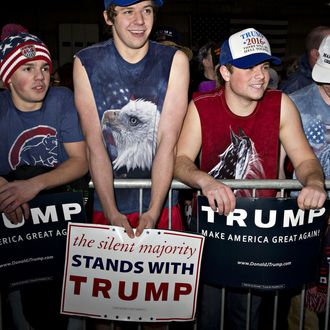
It took the chattering classes a while to figure out that Donald Trump had a particular appeal to white non-college-educated Republican primary voters. But once they figured it out, some leaped to a very different proposition: that Trump could ride an army of white working-class voters to the White House despite his many electoral weaknesses, via boffo performances in normally Democratic-leaning midwestern states like Pennsylvania, Ohio, Michigan, Wisconsin, and Iowa (all carried twice by Barack Obama).
A closer look at the data shows Trump not quite so dominant among non-college-educated white voters (particularly outside the South), and not adding enough value in this one demographic compared to what he loses in others.
The most sophisticated version of the argument that Trump could have a narrow path to victory comes from the estimable Ron Brownstein, who believes that all other things being equal, Trump might reverse some narrow Democratic margins in the Midwest by reversing equally narrow Democratic margins (atypical for the country as a whole) among white working-class voters. I emphasize the qualifier because it’s not all that likely that all other things will be equal with Trump at the top of the ticket; he will surely lose some 2012 Romney voters, perhaps a lot of them.
But it’s important to remember that Republicans are already winning non-college-educated white voters by a big margin. Mitt Romney won an estimated 62 percent of this vote in 2012. Any Trump “bonus” will have to come either from improvements in that number, increased white working-class turnout (against the stiff wind of that group’s declining share of the population), or from some significant redistribution of the white working-class vote by region or state.
One broad indicator of the very different picture you get by shifting from white working-class voters within Republican primaries and white working-class voters generally is in the new ABC/Washington Post analysis of Trump’s favorability ratios among different demographic groups. He comes in at 47-52 among non-college-educated whites, a truly terrible performance not just in terms of his perceived strengths but as compared to Romney’s actual support in the last election.
But there’s some more granular evidence as well of the limits of Trump’s white working-class vote in a competitive environment in the very midwestern cockpit where it should matter most. At the Democratic Strategist (disclosure: I have a long association with that site), Andrew Levison has examined the relative performance of all candidates from both parties in three recent midwestern open primaries, and shown that Trump’s share of the total white working-class vote ranged from 26 percent in Illinois to 30 percent in Ohio (where he actually lost the primary to John Kasich). These numbers should reflect whatever appeal Trump has among marginal voters — i.e., those he can uniquely bring to the polls. Moreover, despite significantly higher overall turnout, the Republican field with Trump in it registered less than overwhelming margins among white working-class voters in Illinois (56 percent) and Michigan (58 percent). Republicans did win 67 percent in Ohio, almost certainly as a product of the appeal not of Trump but of home-state governor John Kasich.
Even if you only discount the GOP percentage of white working-class voters in these midwestern states a few points to reflect across-the-board turnout factors that probably had little to do with any one demographic, it’s not looking like the kind of tsunami that could come close to offsetting Trump’s probable drop in Romney-level support in other parts of the electorate — most notably in Republican-leaning women and highly educated professionals. The ABC/Washington Post analysis put Trump’s favorability ratios at 14-85 among Hispanics, at 18-80 among voters under the age of 35, at 29-68 among white women, and at 23-74 among white college graduates. This is a long, long way from looking like a winning coalition.






























